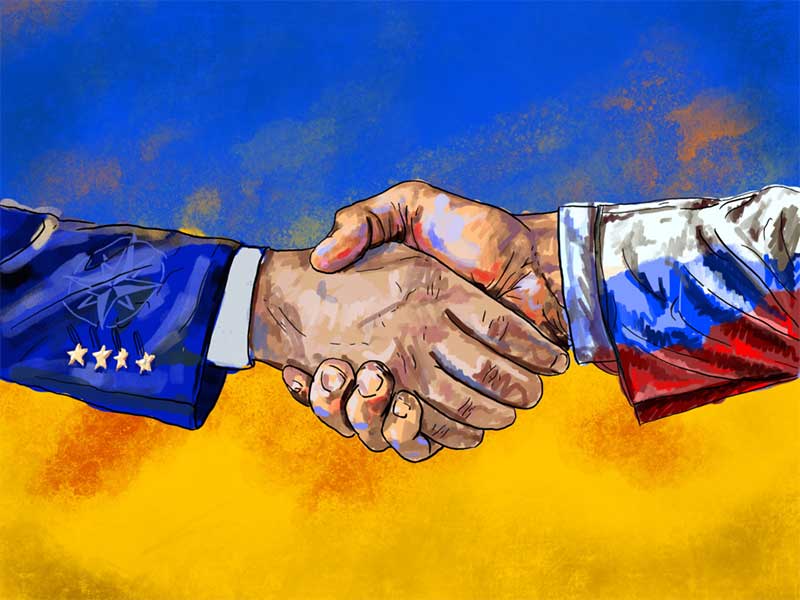
If you’re anything like the average American, you’ve been watching mainstream Western media and seeing every political commentator set up the same rigid dichotomy on the subject of Ukraine and Russia. Ukraine is said to be the virtuous, brave, and resilient little guy who is being picked on. Russia is said to be the immoral, ruthless, and expansionist schoolyard bully looking to “rebuild the Soviet Union.” However, clinging on so tightly to this simple message prevents us from understanding the conflict and identifying the correct solution. In fact, the way we view the conflict has prevented us from seeing Vladimir Putin’s motivation for attacking Ukraine — the expansion of the North Atlantic Trade Organization (NATO). Despite the effort of the West to completely change the structure of international politics, it has become clear that Russia was forced to keep Ukraine as a buffer zone between itself and NATO due to the West’s history of political intervention and Russia’s view of the treaty as something dangerous.
Since NATO was initially formed as a treaty to protect against an attack of Russia’s predecessor, the Soviet Union, it is unsurprising that Russia has declared in meetings following the collapse of the Soviet Union that they do not want NATO to move too far East. According to Lord Ismay, the first Secretary-General of NATO, the organization’s premise is “to keep the Russians out, the Americans in, and the Germans down.” Therefore, as the Cold War came to a close, the Soviet leadership wanted to ensure that they could go through a new nation-building process uninterrupted by NATO aggression. This is why in February 1990, when discussing the expansion of NATO, the U.S. Secretary of State, James Baker, repeatedly promised, “not one inch eastward,” to the Chairman of the Soviet Union, Mikhail Gorbachev. However, at the 2008 Bucharest Summit, the Bush Administration and NATO went back on their words in their proposal for Ukraine and Georgia to join NATO. Snap. That’s the sound of broken promises and the broken illusion of a new liberal order in Europe.
Though it may seem like Ukraine’s prerogative to join NATO, the issue is that by excluding Russia, NATO won’t be able to operate as a peaceful and inclusive treaty; it will continue to act as the same anti-Russian military coalition it was during the Cold War. During an interview with the BBC in 2000 about the possibility of Russia joining NATO, Putin said, “Why not? I do not rule out such a possibility … if it will be an equal partner.” Yet, Russia has never actively pursued or had its terms met by NATO. The consequences of excluding Russia are seen in the 2008 Russo-Georgian War, the 2014 Annexation of Crimea, and, of course, the 2022 Russo-Ukrainian War.
NATO failed to realize that Putin was not on the same page, as he clearly outlined in a 2007 speech at the Munich Security Conference. Putin stated, “I think it is obvious that NATO expansion does not have any relation with ensuring security in Europe. And we have the right to ask: against whom is this expansion intended?” Russia has a right to be worried in this case because while we are inclined to think that Western democracies are always correct, they attempt to dispose of leaders they disagree with left and right. These regime changes often lead to political turmoil and civil unrest. So it’s not unreasonable for Russia to fear what the actions of the West might lead to.
To understand the precipitating causes of the ongoing disaster, we must look at the U.S.-Ukraine Charter on Strategic Partnership and Ukraine’s progression toward the West’s orbit. Following years of new arms deals between the West and Ukraine, in November 2021, the U.S.-Ukraine Charter on Strategic Partnership was introduced with the aim to “underscore…a commitment to Ukraine’s implementation of the deep and comprehensive reforms necessary for full integration into European and Euro-Atlantic institutions.” Concerning this new development and failed negotiations that sought to guarantee that Ukraine will not join NATO, Russian Foreign Minister Sergei Lavrov said, “We reached our boiling point.” This is the main reason we have a war in Eastern Europe.
Yet, the most pressing issue is that since we currently have a war, what should the United States do from here now that we understand the principal cause of the conflict? Once again, the United States is tasked with the responsibility of putting itself in Russia’s shoes. In this country, the idea of the Monroe Doctrine, an allegiant and democratic hemisphere, looms large. Think about the Cuban Missile Crisis. We almost went to nuclear war on the prospect of an enemy with a foreign ideology entering our hemisphere. Should Russia have to hold itself to a different standard than the U.S. and tolerate a NATO-aligned Ukraine? Professor Jeffrey Sachs at Columbia University pointed out, “Neither the U.S. nor Russia wants the other’s military on their doorstep.” Therefore, the United States must create a plan that acknowledges this fundamental truth to create peace and protect Ukrainian sovereignty. Greek economist Yanis Varoufakis expressed it as “a Washington-Moscow agreement that Russia withdraws in exchange for a commitment of Ukrainian neutrality.” Russia needs to have its voice heard because no one would want to see the consequences when Russia is pushed to its breaking point. If no other off-ramp is given to Putin, nuclear destruction would be imminent. The solution that will save the most lives is ensuring a neutral Ukraine through guarantees of denial from NATO and Euro-Atlantic organizations. The United States’ foreign policy needs a dose of pragmatism to save the Ukrainian crisis from spiraling.
-------------------------------
















